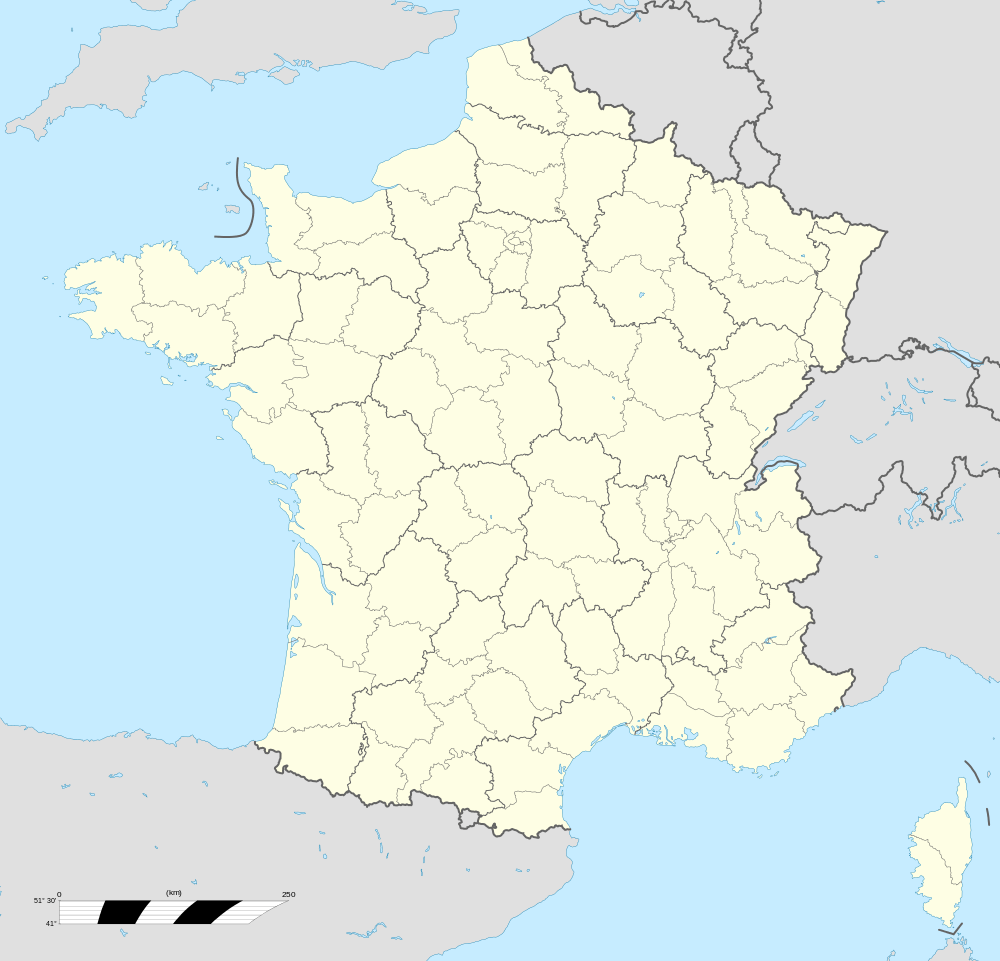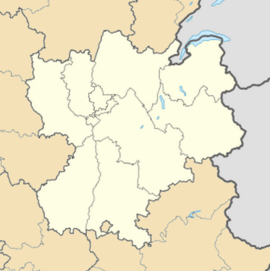Valence, Drôme
| Valence Valença | ||
|---|---|---|
|
Champ de Mars and Kiosque Peynet | ||
| ||
 Valence | ||
|
Location within Rhône-Alpes region  Valence | ||
| Coordinates: 44°56′00″N 4°53′30″E / 44.9333°N 4.8917°ECoordinates: 44°56′00″N 4°53′30″E / 44.9333°N 4.8917°E | ||
| Country | France | |
| Region | Rhône-Alpes | |
| Department | Drôme | |
| Arrondissement | Valence | |
| Intercommunality | Valence-Romans Sud Rhône-Alpes | |
| Government | ||
| • Mayor (2014–2020) | Nicolas Daragon | |
| Area1 | 36.69 km2 (14.17 sq mi) | |
| Population (2012)2 | 62,481 | |
| • Density | 1,700/km2 (4,400/sq mi) | |
| INSEE/Postal code | 26362 / 26000 | |
| Elevation |
106–191 m (348–627 ft) (avg. 123 m or 404 ft) | |
|
1 French Land Register data, which excludes lakes, ponds, glaciers > 1 km² (0.386 sq mi or 247 acres) and river estuaries. 2 Population without double counting: residents of multiple communes (e.g., students and military personnel) only counted once. | ||
Valence (French pronunciation: [va.lɑ̃s]; Occitan: Valença) is a commune in southeastern France, the capital of the Drôme department, situated on the left bank of the Rhône, about 100 km (60 miles) south of Lyon, along the railway line that runs from Paris to Marseilles.
Its inhabitants are called Valentinois. Valence has been recognized as one of the French Towns and Lands of Art and History and has been given a high "four flowers" rating as a tourist destination by the Concours des villes et villages fleuris.
Formerly the duchy of Valentinois, it was ruled by the Duke of Valentinois, a title which is still claimed by the Sovereign Prince of Monaco, though he has no actual administrative control over the area.
Valence lies within the northernmost band of olive tree cultivation: the local saying à Valence le Midi commence ("at Valence the Midi begins") pays tribute to the city's southern culture.
History

The word valence comes from Latin valentia, meaning "strength or capacity". Known in Roman times as Valentia Julia, the city had been the capital of the Segalauni, and the seat of a celebrated school prior to the Roman conquest. It became a colony under Augustus, and was an important town of Viennensis Prima under Valentinian I. It was the seat of a bishopric perhaps as early as the 4th century.
In the 5th century, control of Valentia passed from the Romans to the Alans and other barbarians: in 413, the Goths under Ataulf besieged and captured the brother of the usurper Jovinus, Sebastianus, at Valentia on behalf of the emperor Honorius. In 440, Alans led by Sambida were given deserted lands in Valentia by the Romans.[1] Three years later, Aetius settled the Burgundians in the region, which became part of their kingdom until 534. The city then fell successively under the power of the Franks, the Arabs of Spain, the sovereigns of Arles, the emperors of Germany, the counts of Valentinois, the counts of Toulouse, as well as its own bishops, who struggled to retain the control of the city they had won in the fifth century. These bishops were often in conflict with the citizens and the counts of Valentinois and to strengthen their hands against the latter the pope in 1275 united their bishopric with that of Die.
The citizens put themselves under the protection of the dauphin, and in 1456 had their rights and privileges confirmed by Louis XI and put on an equal footing with those of the rest of Dauphiné, the bishops consenting to recognize the suzerainty of the dauphin. In the 16th century Valence became the center of Protestantism for the province in 1563. The town was fortified by King Francis I. It became the seat of a celebrated university in the middle of the 15th century; but the revocation of the Edict of Nantes in 1685 struck a fatal blow at its industry, commerce and population.
Population
| Historical population | ||
|---|---|---|
| Year | Pop. | ±% |
| 1793 | 6,633 | — |
| 1800 | 7,532 | +13.6% |
| 1806 | 8,212 | +9.0% |
| 1821 | 9,805 | +19.4% |
| 1831 | 10,406 | +6.1% |
| 1836 | 10,967 | +5.4% |
| 1841 | 13,407 | +22.2% |
| 1846 | 13,901 | +3.7% |
| 1851 | 16,122 | +16.0% |
| 1856 | 16,875 | +4.7% |
| 1861 | 18,711 | +10.9% |
| 1866 | 20,142 | +7.6% |
| 1872 | 20,668 | +2.6% |
| 1876 | 23,220 | +12.3% |
| 1881 | 24,502 | +5.5% |
| 1886 | 24,761 | +1.1% |
| 1891 | 25,283 | +2.1% |
| 1896 | 26,212 | +3.7% |
| 1901 | 26,946 | +2.8% |
| 1906 | 28,112 | +4.3% |
| 1911 | 28,706 | +2.1% |
| 1921 | 28,654 | −0.2% |
| 1926 | 30,964 | +8.1% |
| 1931 | 34,275 | +10.7% |
| 1936 | 36,582 | +6.7% |
| 1946 | 40,020 | +9.4% |
| 1954 | 41,470 | +3.6% |
| 1962 | 52,532 | +26.7% |
| 1968 | 62,358 | +18.7% |
| 1975 | 68,604 | +10.0% |
| 1982 | 66,356 | −3.3% |
| 1990 | 63,437 | −4.4% |
| 1999 | 64,260 | +1.3% |
| 2008 | 64,686 | +0.7% |
| 2012 | 62,481 | −3.4% |
Main sights
The Cathedral of St. Apollinaris, which has an architecturally notable apse, was rebuilt in the 11th century in the Romanesque style of Auvergne and consecrated in 1095 by pope Urban II. It suffered extensive damage in the French Wars of Religion, but it was restored in the first decade of the 17th century. The porch and the stone tower above it were rebuilt in 1861. The church contains the monument of Pius VI, who died at Valence in 1799. The library and the museum containing Roman antiquities, sculptures, and a picture gallery are housed in the old ecclesiastical seminary.
The best known of Valence's monuments to its notable inhabitants include those to Émile Augier the dramatist by the duchess of Uzès (1897), and to General Championnet.
Economy
The industries of the city include metallurgical products, textiles, leather goods, jewelry and munitions, and it also serves as a processing and trade center for the surrounding agricultural region.
Some of the big hi-tech companies settled here are leading in their domains like Thales (Former Thomson-CSF, electronic systems for avionics and defence), Crouzet/Schneider (Automatic systems), [SAGEM] (former Alcatel space (Aerospatial systems)), Ascom Monetel (Automatic paytax systems), etc.
The Maison Pic is a world renowned three Michelin star restaurant and hotel, established in 1889.
Transport

The central railway station of Valence is the Gare de Valence-Ville, located just south of the town centre. The station offers connections to Lyon, Grenoble, Avignon, Gap and several regional destinations. In 2001 the Gare de Valence TGV opened along with the LGV Méditerranée, a high-speed rail line extending south from Valence to Marseilles. The station is only 1 kilometre (1 mi) south of the end of the LGV Rhône-Alpes, giving Valence much shorter journey times to northern destinations as well, with a journey to Paris taking 2h11. The TGV station is located 10 km northeast of the town.
A bikesharing scheme called Libélo started in March 2010, offering 200 bicycles for long-term hire and 180 for short-term hire, in 18 locations around the city. Charges are collected by smart card or credit card.[2]
Colleges and universities
The city of Valence is now developing its high level educational role in the Drôme/Ardèche area with one INPG engineering school (ESISAR), one Institut universitaire de technologie (IUT) and annexes of three universities (UPMF, UJF, Stendhal). Many other and more specialized schools are also located in Valence.
International relations
Valence is twinned with:
-
 Asti, Italy, since 1966
Asti, Italy, since 1966 -
 Biberach an der Riß, Germany, since 1967
Biberach an der Riß, Germany, since 1967 -
 Clacton-on-Sea, United Kingdom, since 1969
Clacton-on-Sea, United Kingdom, since 1969 -
 Ijevan, Armenia, since 1996
Ijevan, Armenia, since 1996 -
 Gedera, Israel, since 1997
Gedera, Israel, since 1997 -
 Batroun, Lebanon, since 2005
Batroun, Lebanon, since 2005
Valence is also a partner city with:
-
 Hammamet, Tunisia
Hammamet, Tunisia
Personalities
- Sébastien Chabal (born 8 December 1977), rugby union player, number eight for the Racing Métro and France.
- Bertrand Gille (born 24 March 1978), handball player, for HSV Hamburg, Germany and France national handball team.
- Anne-Sophie Pic (born 12 July 1969), is a chef best known for gaining three Michelin stars for her restaurant, Maison Pic
- Guillaume Gille (born 12 July 1976), handball player, for HSV Hamburg, Germany and France national handball team.
- Louis Nicollin (born 29 June 1943), Owner of 2011-12 Ligue 1 Champions Montpellier HSC and also owner of the waste collection Nicollin group.
- Jacques Tardi (born 30 August 1946), author of various bandes dessinées including Les Aventures extraordinaires d'Adèle Blanc-Sec.
- Jean-Pascal Yao (born January 13, 1977), footballer
See also
References
- ↑ Chronica Gallica of 452, Pith. 124
- ↑ "Libélo, le service vélo de VALENCE AGGLO Sud Rhône-Alpes, Guilherand-Granges, Saint-Péray, Cornas". velo-libelo.fr (in French). Retrieved 2 October 2010.
-
 This article incorporates text from a publication now in the public domain: Chisholm, Hugh, ed. (1911). Encyclopædia Britannica (11th ed.). Cambridge University Press.
This article incorporates text from a publication now in the public domain: Chisholm, Hugh, ed. (1911). Encyclopædia Britannica (11th ed.). Cambridge University Press.
External links
| Wikimedia Commons has media related to Valence (Drôme). |
| ||||||

.png)
